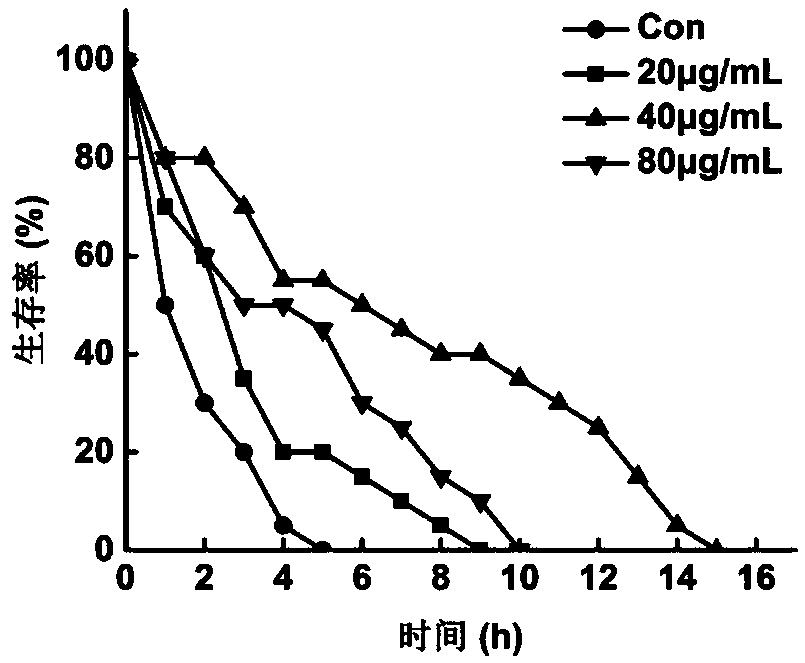Application of forsythia flower yellow pigment in preparing anti-oxidative stress injury drug
An anti-oxidative stress and yellow pigment technology, applied in the field of effective parts of natural medicinal plants, can solve problems such as unseen
- Summary
- Abstract
- Description
- Claims
- Application Information
AI Technical Summary
Problems solved by technology
Method used
Image
Examples
Embodiment 1
[0015] Forsythia yellow pigment preparation:
[0016] Take 20g of dried forsythia flower and grind it into powder, add 2000mL of 95% ethanol, heat the water bath at 50°C, extract by heat reflux; separate by suction filtration, repeat the extraction twice, collect the extract, concentrate it by rotary evaporation, freeze-dry, and collect the dry powder That is the yellow pigment; identified by high pressure liquid chromatography forsythia yellow pigment components mainly include: rutin (236.09mg / g, mass fraction is 23.61%), forsythiaside A (116.95mg / g, mass fraction is 11.69%), pinoresin (82.51mg / g, mass fraction is 8.25%), forsythin (18.23mg / g, mass fraction is 1.83%).
Embodiment 2
[0018] Effects of forsythia anthocyanin on ROS in nematodes
[0019] Nematodes that have grown synchronously to the L4 stage are transferred to NGM medium that does not contain or contain the yellow pigment, cultured in a constant temperature incubator at 20°C for 2 days, washed with M9 buffer to collect the nematodes, and performed on ice with a homogenizer Grind and centrifuge at 12 000r / m to take the supernatant. Take a part to measure protein concentration with BCA kit. A certain amount of the above supernatant was added to a black 96-well plate, and diluted with M9 buffer to make the protein concentration in each well consistent, and DCFH-DA fluorescent probe was added to make the final concentration 25 μM. The volume of each well was 200 μL, and three replicate wells were set up for each group. Incubate at 20°C for 30min. The multifunctional microplate reader detects the fluorescence intensity at an excitation wavelength of 485nm and an emission wavelength of 528nm. ...
Embodiment 3
[0024] Effects of forsythia anthocyanin on the resistance to oxidative stress in wild-type nematodes
[0025] NGM medium containing 500 μM juglone was prepared, and the wild-type N2 nematodes synchronized to the L4 phase were picked to plates without and with the yellow pigment, 30 per plate. The number of surviving nematodes was counted every hour, and the survival rate was calculated until all nematodes died.
[0026] Experimental results such as figure 2 As shown, the average lifespan of nematodes in the control group was 2.05h; the average lifespan of nematodes after the action of 20μg / mL yellow pigment was 3.25h, which was statistically different from the control (P<0.05); the effect of 40μg / mL yellow pigment on nematodes The average lifespan after treatment was extended to 7.25h, compared with the control group, there was a very significant difference (P<0.01); the average lifespan was 4.65h after 80 μg / mL yellow pigment acted on the nematodes, and there was a very sig...
PUM
 Login to View More
Login to View More Abstract
Description
Claims
Application Information
 Login to View More
Login to View More - R&D
- Intellectual Property
- Life Sciences
- Materials
- Tech Scout
- Unparalleled Data Quality
- Higher Quality Content
- 60% Fewer Hallucinations
Browse by: Latest US Patents, China's latest patents, Technical Efficacy Thesaurus, Application Domain, Technology Topic, Popular Technical Reports.
© 2025 PatSnap. All rights reserved.Legal|Privacy policy|Modern Slavery Act Transparency Statement|Sitemap|About US| Contact US: help@patsnap.com


